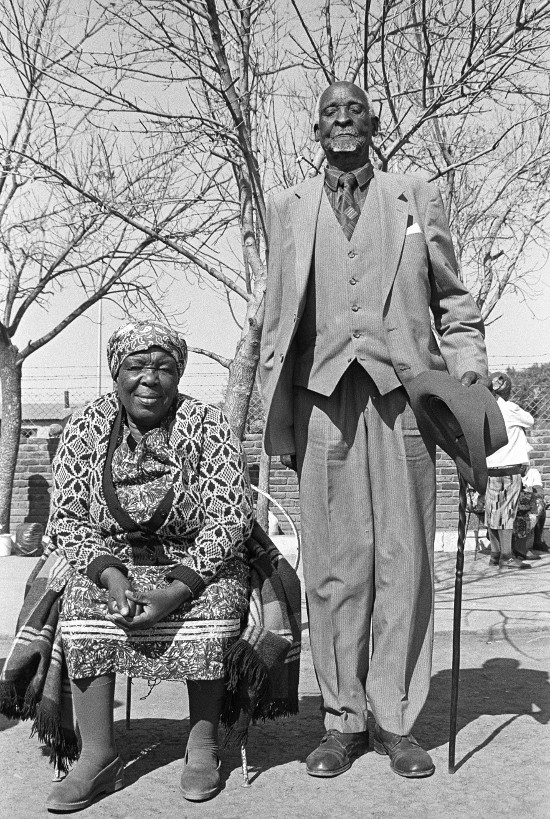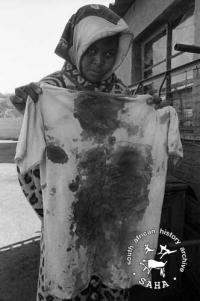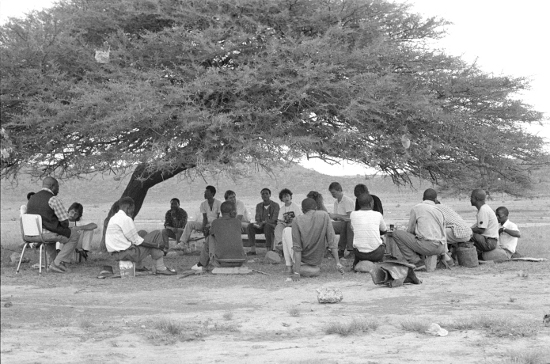Gille de Vlieg donated her collection of photographic images to SAHA in 2009. For the past five years this collection has attracted many researchers and SAHA too has drawn on it as an important source of evocative images for many of its exhibitions and materials relating to ongoing struggles for justice in South Africa.
Activist and photographer Gille de Vlieg was a trained nurse who worked in Pietermaritzburg and London before she moved to Johannesburg where she joined the Black Sash in 1982. She then became involved in the Transvaal Rural Action Committee (TRAC) and by 1983 she had taken up photography to record the disturbing events she was observing: “Hiding behind my lens, I began to see more than the brutality of the times – although there was plenty of that. What became most visible was the spirit of the people resisting that brutality.”
She soon came to realise that she could be both activist and photographer when she met Paul Weinberg in 1984. Weinberg encouraged her to join the collective photo agency Afrapix he co-founded two years earlier. Their focus was on documentary photography with a collective approach of sharing skills and ideas. Overtime Afrapix photographers became known for using the camera as a weapon against apartheid. The SAHA original photograph collection (AL2547) contains images of a number of Afrapix photographers, including by Gille de Vlieg.
In the catalogue of her solo exhibition entitled “Rising Up Together – the work of gille de vlieg”, the activist-photographer defines the moments she photographs as “memories… being imprinted onto my body” and what caught her eye and her lens during the dark decade of the 1980s follows in her vivid description:
 “I was an observer and a participant, attempting to discover what in this abnormal ‘normality’ could be my normal… So much was happening. Dust, late sun, smiles, cold air, thumping feet, smells, shouting, screaming. The flash of sjamboks on bare backs, running, singing, stamping, sirens, monster machines, barbed wire, open rubbish dumps, cattle in the meadows , cattle in the streets, ‘mellow yellows’, slamming metal doors, the clanging of large keys. The pop of guns like champagne corks, clouds of gas, tears, choking, ‘what cold drink do you want?’, comradeship, skinny dogs, police dogs, kittens, babes on backs. Under trees, washing, teaching, smoking, blackened classrooms and beer halls, burning buildings…”.
“I was an observer and a participant, attempting to discover what in this abnormal ‘normality’ could be my normal… So much was happening. Dust, late sun, smiles, cold air, thumping feet, smells, shouting, screaming. The flash of sjamboks on bare backs, running, singing, stamping, sirens, monster machines, barbed wire, open rubbish dumps, cattle in the meadows , cattle in the streets, ‘mellow yellows’, slamming metal doors, the clanging of large keys. The pop of guns like champagne corks, clouds of gas, tears, choking, ‘what cold drink do you want?’, comradeship, skinny dogs, police dogs, kittens, babes on backs. Under trees, washing, teaching, smoking, blackened classrooms and beer halls, burning buildings…”.
This kaleidoscope of images, in essence, summarises her collection of over 700 images at SAHA.
Covering the years 1983 to the early 1990s, these images document her journey through many South Africa provinces (North West, Mpumalanga, Gauteng, Limpopo, Northern Cape, Eastern Cape, KwaZulu-Natal) as she explored and captured events as they happened. She meticulously dated her photographs and events unfold chronologically through her lens.
Gille de Vlieg’s images speak of contrast. She would capture a tranquil moment of living life in a seemingly serene rural setting the one moment, only to be followed by a disturbing image of brutality in the same setting a moment later – still always beautifully framed and captured. However, it is the way she captures people and their emotions that is remarkable. These are images that evoke an emotional response, even many years later.
The repetition of certain themes in her images through the years, such as forced removals, mass funerals, and political protests further strengthens her body of work as a record of the turbulent political past. Capturing gender and lifestyle issues, such as women embroidering, making batik patterns on cloth, pottery, and basket-making remain an important part of her work throughout the eighties.
SAHA has been using Gille de Vlieg’s images in the following physical and virtual exhibitions: ‘Entering Tembisa’, 'Hlanganani Basebenzi - comemmorating South Africa's labour movent', 'Women hold up half the sky - commemorating women in the struggle' and 'The future is ours - commemorating youth in the struggle'. A large number of images relating to forced removals of the Mogopa, Driefontein and Braklaagte communities have also been selected for use in exhibitions produced as part of SAHA’s Land Act 1913 Legacy Project. De Vlieg has been closely involved in both the Tembisa and Land Act projects - as photographer taking photographs of current day communities to contrast the historic images she took during the eighties, and also to share her recollections of her involvement in these communities during that time.

Gille de Vlieg’s images have been widely published locally and abroad, and her work has been included in numerous group exhibitions, such as ‘People’s Portraits’ (South African National Gallery, 1985), ‘Radda Barnen’ (Sweden, 1989) and ‘Malibongwe’ (Netherlands, 1990). A solo exhibition entitled ‘Rising Up Together’, co-curated by Jenny Stretton and Carol Brown was on show at the National Arts Festival in Grahamstown and the Durban Art Gallery in 2009.
Gille de Vlieg is one of the photographers whose work has been selected for the ‘Rise and Fall of Apartheid: Photography and the Bureaucracy of Everyday Life’. Of epic proportions, this exhibition of South African photography by local photographers, co-curated by Okwui Enwezor and Rory Bester, has been on show in New York, Munich and Milan, and is currently on at Museum Africa in Newtown, Johannesburg until June 2014.
See inventory for the Gille de Vlieg photographic collection (AL3274)
See inventory for the SAHA original photograph collection (AL2547)
See inventory for the Tembisa project collection (AL3288)






 “I was an observer and a participant, attempting to discover what in this abnormal ‘normality’ could be my normal… So much was happening. Dust, late sun, smiles, cold air, thumping feet, smells, shouting, screaming. The flash of sjamboks on bare backs, running, singing, stamping, sirens, monster machines, barbed wire, open rubbish dumps, cattle in the meadows , cattle in the streets, ‘mellow yellows’, slamming metal doors, the clanging of large keys. The pop of guns like champagne corks, clouds of gas, tears, choking, ‘what cold drink do you want?’, comradeship, skinny dogs, police dogs, kittens, babes on backs. Under trees, washing, teaching, smoking, blackened classrooms and beer halls, burning buildings…”.
“I was an observer and a participant, attempting to discover what in this abnormal ‘normality’ could be my normal… So much was happening. Dust, late sun, smiles, cold air, thumping feet, smells, shouting, screaming. The flash of sjamboks on bare backs, running, singing, stamping, sirens, monster machines, barbed wire, open rubbish dumps, cattle in the meadows , cattle in the streets, ‘mellow yellows’, slamming metal doors, the clanging of large keys. The pop of guns like champagne corks, clouds of gas, tears, choking, ‘what cold drink do you want?’, comradeship, skinny dogs, police dogs, kittens, babes on backs. Under trees, washing, teaching, smoking, blackened classrooms and beer halls, burning buildings…”.